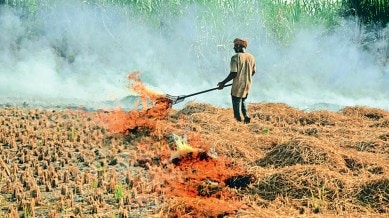Stay updated with the latest - Click here to follow us on Instagram
Punjab and Haryana farm fires dip after rain — and Delhi gets a breather from toxic air
The AQI has been gradually improving in the last four days, aided by favourable wind patterns. While Delhi had recorded an AQI of 291 (Poor) on Tuesday, the air quality was 366 (Very Poor) on Sunday.

With Punjab and Haryana receiving scattered rainfall since Tuesday under the influence of a Western Disturbance, Delhi’s air quality on Wednesday witnessed a brief respite, registering an air quality index (AQI) of 202 in the ‘Poor’ category, as instances of farm fires saw a dip — recording the lowest figure in six years from November 1 to 5.
According to data from NASA’s VIIRS satellite, 1,291 farm fires were recorded in Punjab between November 1 and 5 this year, compared to 9,730 during the same period last year. Haryana recorded 72 fires (317 last year), and Uttar Pradesh 144 (249 last year) during the same period. The data shows that this is the lowest early November count for both Punjab and Haryana since 2020. (See box)
monthly limit of free stories.
with an Express account.
This comes at a time when the region, starting November first week, usually faces the peak of stubble burning cases.
The AQI has been gradually improving in the last four days, aided by favourable wind patterns. While Delhi had recorded an AQI of 291 (Poor) on Tuesday, the air quality was 366 (Very Poor) on Sunday.
However, while number of farm fires saw a dip, local emissions from transport and industrial sectors continued to dominate Delhi’s particulate matter (PM2.5) pollution load.
According to India Meteorological Department’s (IMD) Met Centre Chandigarh, a drizzle was reported on Tuesday night and early Wednesday. Under the influence of the Western Disturbance, Haryana also saw light to moderate rain with thunderstorms at isolated places, as per IMD. The combination of rainfall and stronger winds has helped disperse pollutants and limit the transportation of smoke towards Delhi from Punjab and Haryana.
Southeasterly winds prevailed over the Capital on Wednesday, reaching up to 14 kmph, strong enough to prevent the accumulation of pollutants. When the winds move southeasterly, the impact of stubble fires in Punjab and Haryana on Northwest Delhi is minimal.
According to the latest data from IITM’s Decision Support System (DSS) for air quality management, the share of stubble burning in Delhi’s PM2.5 was 2.07% on November 4. In contrast, the transport sector contributed 16.54%, followed by emissions from Gautam Buddha Nagar (8.98%), Faridabad (7.84%) and Gurgaon (7.04%). According to the forecast, the contribution from farm fires may rise slightly to 29% by November 7 as dry conditions return.
According to IMD officials, the weather system, which caused snowfall in Jammu and Kashmir and scattered rainfall in Punjab on Wednesday, has now moved eastwards. Dry conditions are expected to prevail across the northern plains from Thursday, with clear sky and westerly winds of 8-12 kmph. The induced cyclonic circulation over Punjab persists, said the IMD on Wednesday evening.
“The visibility was very low on Saturday. This changed on Sunday as a gust was also reported at 16 knots (around 30 kmph) in Palam. Throughout Sunday, winds remained strong and reached around 20 kmph. The impact of Western Disturbance was also felt in Jammu and Kashmir, Punjab and isolated regions in Haryana,” said Krishna Mishra, senior IMD official.
“The minimum temperature will fall only slightly to around 15 degrees Celsius, and there is no probability of fog… But dry conditions will persist in the northern plains from November 6,” Mishra added.
The Indian Agricultural Research Institute (IARI) reported that 382 residue burning events were detected across six North Indian states on November 5, including 94 in Punjab and 13 in Haryana. “Detection was hampered by the presence of clouds over central Uttar Pradesh and north Madhya Pradesh,” it noted on Tuesday.
Meanwhile, to combat pollution, the Delhi government has launched an intensive drive to deep clean all Public Works Department (PWD) by deploying 200 maintenance vans. Each van will deep clean at least 200 m of a road daily.